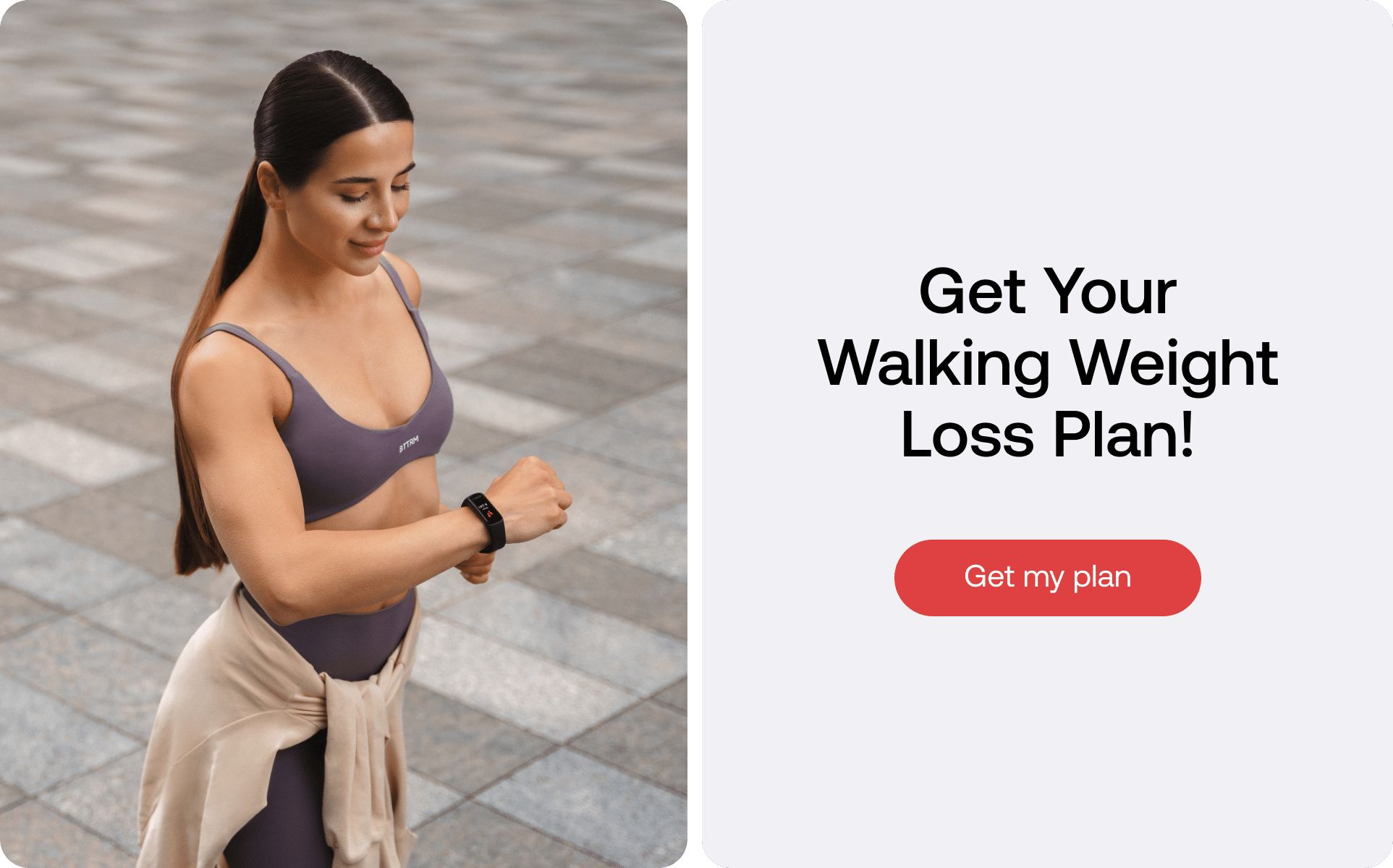How many miles to walk a day to lose weight? This is a question that many people looking into a walking plan to lose weight might find themselves asking. As an exercise plan for weight loss, walking is one of the most free, easiest, most accessible, yet most overlooked ways of losing weight.
Why this is the case is a discussion for another day. But if you truly want to start getting rid of the excess weight that has been plaguing you all year round, it is high time you seriously consider walking to lose weight.
Read on to learn more about this simple yet effective workout, how it can help you lose body fat, get a slimmer waist and much more.
Does Walking 3 Miles A Day Help Lose Weight?
Yes, walking 3 miles a day can help you lose weight, especially if you have been leading a mostly sedentary lifestyle.
As we all know, weight loss comes from burning calories. While our bodies do burn calories even while at rest – i.e. when sleeping, sitting on the couch watching TV, sunbathing at the beach, etc. – these calories burned are often not nearly enough to help you lose excess weight.
To kickstart a proper weight loss journey, you need to burn more calories than you consume. This can be done through increasing your day-to-day physical activity.
The CDC recommends at least 150 minutes of moderate-intensity physical activity each week (30 minutes a day, five days a week), or 75 minutes of vigorous-intensity activity every week plus two days a week of muscle-strengthening activities for all adults (8).
Walking 3 miles a day (especially brisk walking ) falls under moderate-intensity aerobic activity that can help you burn more calories throughout the day, leading to eventual weight loss.
According to Harvard Health Publishing walking 3 miles calories burned in just 30 minutes could be anywhere between 100 to 160 calories – heavier people will burn more calories than lighter people (3). Calories burned from walking 1 hour at the same pace will help you burn anywhere between 200 to 320 calories a day.
Yanking yourself back in shape has never been so easy with our game-changing fitness app! Start transforming your life with BetterMe!
Can You Lose Belly Fat Walking?
Yes, you can absolutely lose belly fat by simply walking more – a fact proven by several scientific studies over the years.
- In a study published in the Journal of Exercise Nutrition & Biochemistry, 20 obese women were divided into groups – a control and an exercise group.
The women in the exercise group were required to participate in walking exercises, 3 days a week for 50-70 minutes, with a target of burning 400 kcal per workout session. The study took a total of 12 weeks.
At the end of the study, not only had the serum insulin resistance markers improved in the women in the exercise group, but their abdominal and total body fat had also significantly reduced (5).
- One study review looking at the effects of aerobic vs. resistance exercise training on abdominal fat found that aerobic exercises (such as walking) worked incredibly well to reduce abdominal fat in overweight/obese participants (2).
- An older review published in the International Journal of Obesity in 2007 found that in studies consisting of 582 participants aerobic exercise led to significant weight loss and abdominal fat reduction (1).
- In another study, participants were divided into 3 groups
- Group 1 had to walk for 30 minutes a day, 5 days a week
- Group 2 were asked to walk for 60 minutes, 5 days a week
- Group 3 only had to change their diets
The entire study took 12 weeks. At the end of the study, researchers found that all participants in all 3 groups showed similar and significant declines in body weight, percentage body fat, BMI, WHR, fat mass, fat-free mass and diastolic blood pressure.
Their total cholesterol and triacylglycerol levels showed significant improvement and their waist circumferences had also reduced. Despite this, researchers also noted that the walking exercise groups had significantly better results, as compared to the diet only group (4).
Looking at all these findings, we can conclude that walking 1 hour a day for a month – or even 30 minutes if you don’t have a lot of free time – can lead to both weight loss and a flatter tummy.
Can You Lose Weight Walking 1 Hour A Day?
Yes, you can lose weight by walking for just 1 hour a day.
As seen from the studies in the section above, consistent walking for 30 minutes to an hour over a couple of months will lead to reduced belly fat and overall weight loss.
Read more: Calories Burned Walking 1 Hour: How to Calculate the Calories You Burn While Walking
What Is A Flat Tummy Walk?
This is a type of walking exercise where participants are required to engage their core muscles as they walk at a brisk pace. Proponents of the ‘flat tummy walk’ claim that by doing this, you can tone and strengthen the muscles in your abdomen which can eventually lead to a flatter tummy.
But does it work?
Flat tummy walking seems to be yet another sensationalized internet exercise with no scientific backing. What we can say about this is:
1. Stronger core muscles do not necessarily mean a flatter tummy. A flat tummy is caused by less fat around the tummy area. The excess fat usually lays over the abdominal muscles essentially ‘hiding’ them.
When you lose belly fat, you may start seeing some core muscle definition, and working on strengthening these muscles through exercises that target them, directly and indirectly, will cause them to be more pronounced and visible – thus the enviable ‘six pack’.
2. Keeping your core muscles engaged through any exercise is actually a good thing.
Strong core/abdominal muscles equal better balance and stability, not only during workouts but also in day-to-day activities. Strong abdominal muscles also mean a stronger back, thus a lower risk of low back pain and better posture (11).
If you wish to cinch your waist, tone up your bat wings, blast away the muffin top – our fitness app was created to cater to all your needs! BetterMe won’t give excess weight a chance!
What Is The Best Time For Walking To Lose Weight?
There is no universal best time to walk or exercise. The best time to walk is whichever one works best for you. Some people prefer to work out at dawn, others in the morning, some at lunchtime, others after work and some late at night when no one is at the gym.
Pick whichever time works for you. As long as you remain consistent with your walks and try different things to increase the intensity – to avoid plateauing – you will see results.
Ps. If you choose to walk outside, please remember to remain vigilant, especially if you walk very early in the morning or late at night and in areas without a lot of people.
Slow Or Brisk Walking For Weight Loss: Which Is Better?
Whichever speed works best for you, will lead to weight loss.
This is according to one study published in 2022 where researchers were comparing different walking speeds and their effects on abdominal and total body fat loss in postmenopausal women. At the end of the study, they found that all walking speeds – slow or brisk walking – can lead to total body fat loss.
However, interestingly enough, they found that in overweight subjects slow walking produced more rapid, clearer, and greater changes than brisk walking, at least in the initial stages of the experiment (6).
Read more: Calories Burned Walking 2 Miles: A Key to Weight Loss?
FAQs
How Many Calories Burned Walking 2 Miles?
Depending on your walking speed as well as how much you weigh, you can burn 100 to 200 calories in just 30 minutes (3).
If I Walk 2 Hours A Day, How Much Weight Will I Lose?
Because of the many different factors – aside from exercise – affecting calorie burning, it is hard to quantify how much weight an individual can lose in a week, month or several months of walking 2 hours a day (7).
However, you will realize that your walking plan is working if you notice that you are losing 1 to 2 pounds a week (4 to 8 pounds a month) (9).
Why Am I Not Losing Weight Walking 10,000 Steps A Day?
Walking 10,000 steps is one of the most popular targets for people looking to shed some extra pounds through this exercise. But what happens if you note that this isn’t working for you?
Here are some reasons why despite walking 10k steps a day, your weight isn’t going down:
- You have plateaued – A weight loss plateau is a situation where your weight loss suddenly stops. It neither goes up nor down and remains at the same number.
Plateaus happen when your body acclimates to your exercise routine. When you have been doing the same exercise routine for a while, your body adjusts and makes this the new normal.
If you realize you have plateaued, you need to go back to the drawing board and adjust your exercise routine and diet to fit this new normal. Analyze your food intake, increase your steps from 10,000, walk-in areas with more of an incline, include lean protein, healthy fats, complex carbs, and plenty of fruit and vegetables in your diet, reduce stress, drink more water, etc.
- You are eating too much or too little – If a plateau is not your problem, then your diet could be the issue. Weight loss requires a calorie deficit, if you are eating at a surplus, all that walking will be for naught as you will not see positive results.
A too big calorie deficit is also not a good thing. When you eat too little, your body starts to adapt and it may hold on to fat instead of burning it. A proper calorie deficit starts with cutting just 500 calories from your normal diet. Get a reputable calorie tracker to help you find your ideal deficit.
- Get enough sleep – Lack of sleep leads to overeating which negatively affects healthy eating and your calorie deficit diet (10).
- Fix your diet – Being on a calorie deficit isn’t enough. For proper weight loss results, your diet needs to be as healthy as possible.
Eat more vegetables and protein, moderate fats, and quality carbs. This doesn’t mean avoiding carbs completely (unless you are following a low-carb diet like keto) – it simply means that you should avoid simple carbs and consume more complex carbs.
- Drink more water – Not only does it prevent dehydration when working out but water can also increase your metabolism helping you burn more calories throughout the day. Coffee and tea are also good drink options to help temporarily boost your metabolic rate.
Does Walking Tone The Butt?
Not necessarily. To tone effectively, you will need to engage in regular resistance training as well.
While walking is a full-body workout, engaging all muscles of the lower body, walking is primarily an aerobic exercise. To seamlessly add resistance to your walks, you could find uphill routes or incorporate stair intervals.
If you want to create that juicy Instagram-worthy bubble butt, walking alone will not cut it. Add some butt-specific exercises like walking lunges, traditional squats, jumping squats, etc. to your routine. You could also do a quick butt workout routine after walking to activate the glutes and build that peach shape that you desire.
How Long Does It Take To See Results From Walking?
Physical weight loss results from any kind of workout plan – aerobic, weight lifting, HIIT, etc. – take much longer to see than people think. According to Women’s Health Magazine, it will take anywhere between 8 to 12 weeks for you to start seeing results – slight changes however, may be seen within 4 to 6 weeks.
However, if you look past the physical, you may start noticing changes much earlier than this, i.e. you could note that you are not panting as much in week 2 of walking than week 1. You may notice that you sweat less while using the same walking speed, you could also see that you are walking the same distance in less time, etc.
Internal/cardiovascular changes will happen faster than physical changes.
Does Walking Reduce Waist Size?
Yes, it does.
As seen in the ‘can you lose belly fat walking’ section above, several studies have proved that walking is effective in reducing belly fat and waist size.
The Bottom Line
Walking is a fantastic way to lose weight and be more active for a healthier life. You do not even need to go big in the beginning.
Simply walking 1 mile a day or walking for 30 minutes a day can lead to significant changes not only to your weight and waist circumference but to your cardiovascular and mental health too.
Challenge yourself today and you’ll be surprised by the amount of change you will see by the end of the year!
DISCLAIMER:
This article is intended for general informational purposes only and does not serve to address individual circumstances. It is not a substitute for professional advice or help and should not be relied on for making any kind of decision-making. Any action taken as a direct or indirect result of the information in this article is entirely at your own risk and is your sole responsibility.
BetterMe, its content staff, and its medical advisors accept no responsibility for inaccuracies, errors, misstatements, inconsistencies, or omissions and specifically disclaim any liability, loss or risk, personal, professional or otherwise, which may be incurred as a consequence, directly or indirectly, of the use and/or application of any content.
You should always seek the advice of your physician or other qualified health provider with any questions you may have regarding a medical condition or your specific situation. Never disregard professional medical advice or delay seeking it because of BetterMe content. If you suspect or think you may have a medical emergency, call your doctor.
SOURCES:
- A dose-response relation between aerobic exercise and visceral fat reduction: systematic review of clinical trials (2007, nature.com)
- A systematic review and meta-analysis of the effect of aerobic vs. resistance exercise training on visceral fat (2011, onlinelibrary.wiley.com)
- Calories burned in 30 minutes for people of three different weights (2021, health.harvard.edu)
- Dose–response effect of walking exercise on weight loss. How much is enough? (2002, nature.com)
- Effect of walking exercise on abdominal fat, insulin resistance and serum cytokines in obese women (2014, ncbi.nlm.nih.gov)
- Effects of Walking Speed on Total and Regional Body Fat in Healthy Postmenopausal Women (2022, ncbi.nlm.nih.gov)
- Factors Affecting Energy Expenditure and Requirements (n.d., ncbi.nlm.nih.gov)
- How much physical activity do adults need? (2022, cdc.gov)
- Losing Weight (2023, cdc.gov)
- Sleep Deprivation: Effects on Weight Loss and Weight Loss Maintenance (2022, ncbi.nlm.nih.gov)
- The real-world benefits of strengthening your core (2012, health.harvard.edu)










